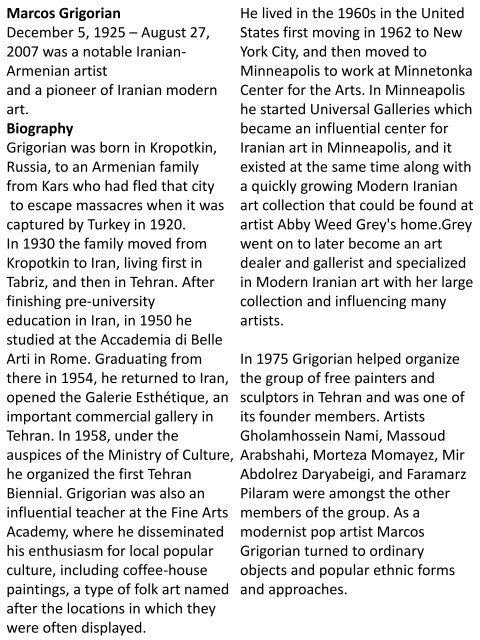Aziz art March 2018
History of art(west and Iranian)-contemporary art-Reza Khodadadi-Alfred Basbous-Marcos Grigorian-Middle East art -surrealism painting -Iranian art auction -Famous Iranian art -middle east artist-Famous iranian artist-humanity-Iranian#Iranian contemporary art -middle east -surrealism painting -visual art -gallery-contemporary art -Qajar art - art auction -exhibition -modern art -London -USA - UK -Aziz Anzabi-Famous Persian artist-painting-art-life-man-woman History of art(west and Iranian)-contemporary art-Reza Khodadadi-Alfred Basbous-Marcos Grigorian-Middle East art -surrealism painting -Iranian art auction -Famous Iranian art -middle east artist-Famous iranian artist-humanity-Iranian#Iranian contemporary art -middle east -surrealism painting -visual art -gallery-contemporary art -Qajar art - art auction -exhibition -modern art -London -USA - UK -Aziz Anzabi-Famous Persian artist-painting-art-life-man-woman
Marcos Grigorian December 5, 1925 – August 27, 2007 was a notable Iranian- Armenian artist and a pioneer of Iranian modern art. Biography Grigorian was born in Kropotkin, Russia, to an Armenian family from Kars who had fled that city to escape massacres when it was captured by Turkey in 1920. In 1930 the family moved from Kropotkin to Iran, living first in Tabriz, and then in Tehran. After finishing pre-university education in Iran, in 1950 he studied at the Accademia di Belle Arti in Rome. Graduating from there in 1954, he returned to Iran, opened the Galerie Esthétique, an important commercial gallery in Tehran. In 1958, under the auspices of the Ministry of Culture, he organized the first Tehran Biennial. Grigorian was also an influential teacher at the Fine Arts Academy, where he disseminated his enthusiasm for local popular culture, including coffee-house paintings, a type of folk art named after the locations in which they were often displayed. He lived in the 1960s in the United States first moving in 1962 to New York City, and then moved to Minneapolis to work at Minnetonka Center for the Arts. In Minneapolis he started Universal Galleries which became an influential center for Iranian art in Minneapolis, and it existed at the same time along with a quickly growing Modern Iranian art collection that could be found at artist Abby Weed Grey's home.Grey went on to later become an art dealer and gallerist and specialized in Modern Iranian art with her large collection and influencing many artists. In 1975 Grigorian helped organize the group of free painters and sculptors in Tehran and was one of its founder members. Artists Gholamhossein Nami, Massoud Arabshahi, Morteza Momayez, Mir Abdolrez Daryabeigi, and Faramarz Pilaram were amongst the other members of the group. As a modernist pop artist Marcos Grigorian turned to ordinary objects and popular ethnic forms and approaches.
- Page 1 and 2: Aziz Art March2018 Marcos Grigorian
- Page 3 and 4: NOROOZ 1
- Page 6 and 7: Nowruz is believed to have been Anc
- Page 9 and 10: Boyce and Grenet explain the Hall,
- Page 11 and 12: In the book Nowruznama drink immort
- Page 13 and 14: 11
- Page 15 and 16: Dr. Reza Khodadadi born Ardabil,liv
- Page 18 and 19: Alfred Basbous 16
- Page 20 and 21: The following years, he acquired an
- Page 22 and 23: In 1998, he founded and chaired the
- Page 26: He used ethnic food such as "Nan Sa
Marcos Grigorian<br />
December 5, 1925 – August 27,<br />
2007 was a notable Iranian-<br />
Armenian <strong>art</strong>ist<br />
and a pioneer of Iranian modern<br />
<strong>art</strong>.<br />
Biography<br />
Grigorian was born in Kropotkin,<br />
Russia, to an Armenian family<br />
from Kars who had fled that city<br />
to escape massacres when it was<br />
captured by Turkey in 1920.<br />
In 1930 the family moved from<br />
Kropotkin to Iran, living first in<br />
Tabriz, and then in Tehran. After<br />
finishing pre-university<br />
education in Iran, in 1950 he<br />
studied at the Accademia di Belle<br />
Arti in Rome. Graduating from<br />
there in 1954, he returned to Iran,<br />
opened the Galerie Esthétique, an<br />
important commercial gallery in<br />
Tehran. In 1958, under the<br />
auspices of the Ministry of Culture,<br />
he organized the first Tehran<br />
Biennial. Grigorian was also an<br />
influential teacher at the Fine Arts<br />
Academy, where he disseminated<br />
his enthusiasm for local popular<br />
culture, including coffee-house<br />
paintings, a type of folk <strong>art</strong> named<br />
after the locations in which they<br />
were often displayed.<br />
He lived in the 1960s in the United<br />
States first moving in 1962 to New<br />
York City, and then moved to<br />
Minneapolis to work at Minnetonka<br />
Center for the Arts. In Minneapolis<br />
he st<strong>art</strong>ed Universal Galleries which<br />
became an influential center for<br />
Iranian <strong>art</strong> in Minneapolis, and it<br />
existed at the same time along with<br />
a quickly growing Modern Iranian<br />
<strong>art</strong> collection that could be found at<br />
<strong>art</strong>ist Abby Weed Grey's home.Grey<br />
went on to later become an <strong>art</strong><br />
dealer and gallerist and specialized<br />
in Modern Iranian <strong>art</strong> with her large<br />
collection and influencing many<br />
<strong>art</strong>ists.<br />
In 1975 Grigorian helped organize<br />
the group of free painters and<br />
sculptors in Tehran and was one of<br />
its founder members. Artists<br />
Gholamhossein Nami, Massoud<br />
Arabshahi, Morteza Momayez, Mir<br />
Abdolrez Daryabeigi, and Faramarz<br />
Pilaram were amongst the other<br />
members of the group. As a<br />
modernist pop <strong>art</strong>ist Marcos<br />
Grigorian turned to ordinary<br />
objects and popular ethnic forms<br />
and approaches.



